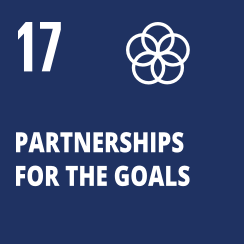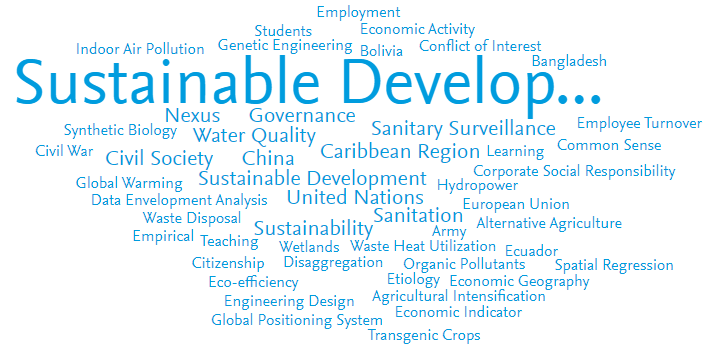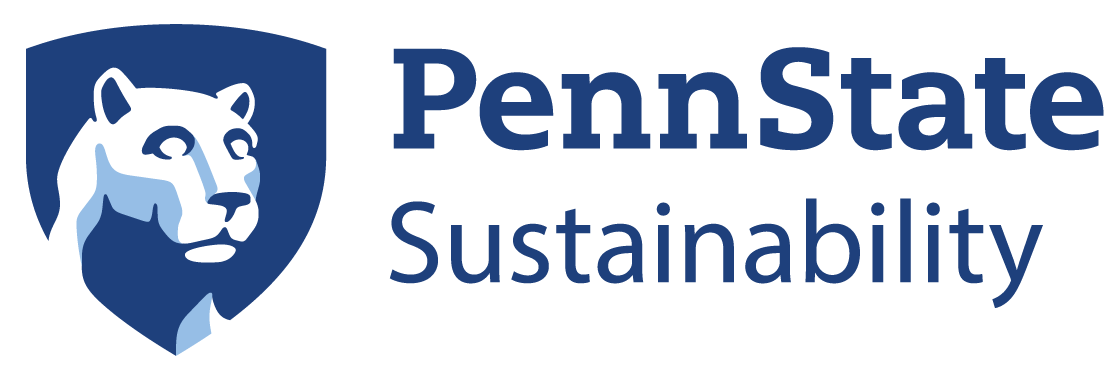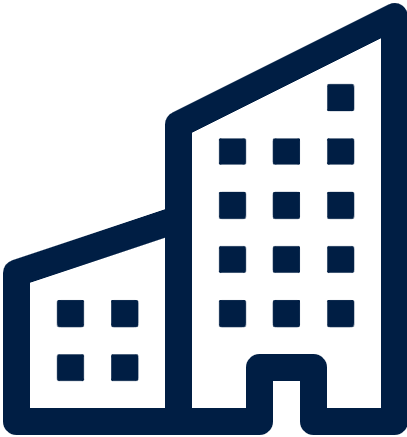
Strengthen the means of implementation and revitalize the global partnership for sustainable development
This multifaceted goal targets a range of support systems to advance the SDGs globally with a focus on countries supporting one another, particularly developing countries, in areas of finance; technology; information sharing; trade and economic stability; public, public-private and civil society partnerships; and, capacity-building. See below for Penn State’s work on the targets and indicators for this goal.

Source: SciVal.com | This word cloud was created using publications from Penn State researchers
Related News
The GREEN Program founder Melissa Lee to give Lattman Lecture on Oct. 18
Link: The GREEN Program founder Melissa Lee to give Lattman Lecture on Oct. 18
Penn State professor helps spearhead global plant-health conference in France
Link: Penn State professor helps spearhead global plant-health conference in France
Experts discuss critical infrastructure protection at annual Penn State workshop | Penn State University (psu.edu)
Link: Experts discuss critical infrastructure protection at annual Penn State workshop | Penn State University (psu.edu)
Energy Law and Policy webinars to focus on Regional Greenhouse Gas Initiative | Penn State University (psu.edu)
Link: Energy Law and Policy webinars to focus on Regional Greenhouse Gas Initiative | Penn State University (psu.edu)
Brandywine students produce first podcasts for national environmental conference | Penn State University (psu.edu)
Link: Brandywine students produce first podcasts for national environmental conference | Penn State University (psu.edu)
Engineering design project focuses on climate change and sustainability | Penn State University (psu.edu)
Link: Engineering design project focuses on climate change and sustainability | Penn State University (psu.edu)
Supporting Evidence
Yes, the university has direct involvement in, or input into, national government or regional nongovernmental organizations SDG policy development which includes identifying problems and challenges, developing policies and strategies, modelling likely futures with and without interventions, monitoring and reporting on interventions, and enabling adaptive management.
Penn State is a member of the UN Sustainable Development Solutions Network (SDSN) which promotes integrated approaches to implement the SDGs through education, research, policy analysis and global cooperation. SDSN members work closely with businesses and governments, particularly around the development and scaling up of new solutions.
Penn State faculty conduct research and provide expertise that informs policy development. Penn State’s Earth System Science Center uses climate system models to understand the climate system and develop modeling tools to serve Penn State and the broader community.
Penn State’s Center for Energy Law and Policy provides a hub for interdisciplinary research around pressing energy issues where technology, social and legal frameworks are ingredients to successful policy design implementation. It brings together scholars to explore how energy research might be used to inform regulatory approaches.
Yes, Penn State initiates and participates in cross-sectoral dialogue about the SDGs as a member of National Council for Science and the Environment(NCSE) which engages scientists, educators, policymakers, business leaders, and government officials to advance the use of science to inform environmental decision-making and participates in annual conferences. The NCSE Drawdown 2021 Conference featured several presenters from Penn State.
Penn State initiated and participated in cross-sectoral dialogue about the SDGs by partnering with Project Drawdown to co-host a conference for government, NGOs and academics and host Drawdown Scholars each year. This partnership explores and enhances plans to reverse global warming by clarifying a positive solutions-oriented path for action on climate change. By working with researchers from across the world, the team has already identified 100 of substantive solutions to address climate change.
Yes, the university participates in international collaboration on gathering or measuring data for the SDGs.
Penn State gathers and measures SDG data as a member of the Water, Energy, Food Nexus in Africa Initiative. This network of academic, public and private sector institutions addresses scientific, social, environmental and engineering challenges at the water-energy-food nexus. A Penn State faculty member is the initiative’s director.
As a member of the UN Sustainable Development Solutions Network we partner with a variety of organizations to assess progress towards SDG achievement at the national and local level.
Penn State is a research collaborator for Project Drawdown which supports and advances the gathering and measuring of data for the SDGs.
Our Experiential Digital Global Engagement program supports faculty focused on addressing SDGs with a Central Asia University Partnership grant from the American Councils for International Education.
Penn State collaborates with the U.N. Economic Commission for Europe to support the Global Building Network aimed at advancing building science, construction, and management to address SDGs.
Yes, through international collaboration and research the university reviews comparative approaches and develops international best practices on tackling the SDGs.
Penn State’s Global Building Network is an international collaboration of universities, non-governmental organizations, UN Member States, regions, municipalities and industry partners to develop best practices to address SDGs. The overall goal of the Network is to eventually eliminate, fossil fuel energy utilization in the operation of residential and commercial buildings while acquiring operational data that serves to continuously improve the methodology.
Penn State is a member of the UN Sustainable Development Solutions Network (SDSN) which promotes integrated approaches to implement the SDGs through education, research, policy analysis and global cooperation.
Penn State’s College of Agriculture’s Gender Equity through Agricultural Research and Education network of interdisciplinary scholars and researchers mission is to research innovative and sustainable gender integrated development practices.
Yes, Penn State collaborates with NGOs on student volunteer opportunities, research programs, and educational resources.
As a member of The Forum on Education Abroad Penn State collaborates to advance the SDGs through Education Abroad.
A UNESCO Chair in the College of Engineering at Penn State collaborates with a variety of NGOs to increase the number of youth and adults who have advanced technical and vocational skills.
Student Affairs collaborates with many NGOs to provide student volunteer programs.
The Sustainable Communities Collaborative collaborates with NGOs to connect them to faculty for engaged scholarship opportunities.
Connecting Humans and Nature through Conservation Experiences program is an interdisciplinary environmental education program that collaborates with NGOs to support study abroad international field courses that immerse students in real-world environmental research and conservation efforts.
The SDG Progress website serves as the public report on progress by The Pennsylvania State University towards the United Nations Sustainable Development Goals.
Progress against the SDGs is also published in the Sustainability Institute biennial report and on SDG1 in news and journal articles. Reports on SDG1 can be accessed online using the Pure Elsevier search.
The university publishes progress against the SDGs in the Sustainability Institute biennial report and on SDG1 in news and journal articles. Reports on SDG1 can be accessed online using the Pure Elsevier search and on our SDG2 webpage by clicking the Research icon. We track progress on SDG2 in our STARS report which addresses support for a campus food bank.
The university publishes progress against the SDGs in the Sustainability Institute biennial report and on SDG3 in news and journal articles. Reports on SDG3 can be accessed online using the Pure Elsevier search and on our SDG3 webpage by clicking the Research icon. We track progress on SDG3 in our STARS report which covers our Wellness Program and Smoke-free environments policy
The university publishes progress against the SDGs in the Sustainability Institute biennial report and on SDG4 in news and journal articles. Reports on SDG4 can be accessed online using the Pure Elsevier search and on our SDG4 webpage by clicking the Research icon. We track progress on SDG4 in our STARS report which tracks data related to affordability and access.
The university publishes progress against the SDGs in the Sustainability Institute biennial report and on SDG5 in news and journal articles. Reports on SDG5 can be accessed online using the Pure Elsevier search and on our SDG5 webpage by clicking the Research icon. We track progress on SDG5 in our STARS report which tracks progress on Diversity and Equity Coordination (section PA-5; 1.67/2.00 points), Assessing Diversity and Equity (section PA-6; 1.00/1.00 points), and Support for Underrepresented Groups sections (section PA-7; 3.00/3.00 points).
The university publishes progress against the SDGs in the Sustainability Institute biennial report and on SDG6 in news and journal articles. Reports on SDG6 can be accessed online using the Pure Elsevier search and on our SDG6 webpage by clicking the Research icon. We track progress on SDG6 in our STARS report which tracks progress on how we track water and sanitation management in sections OP-21, Water Use, and OP-22, Rainwater Management.
The university publishes progress against the SDGs in the Sustainability Institute biennial report and on SDG7 in news and journal articles. Reports on SDG7 can be accessed online using the Pure Elsevier search and on our SDG7 webpage by clicking the Research icon. We track progress on SDG7 in our STARS report which tracks progress on building energy efficiency in section OP-5 and on clean and renewable energy in section OP-6.
Penn State’s Greenhouse Gas emissions dashboard tracks our progress on reducing emissions.
The university publishes progress against the SDGs in the Sustainability Institute biennial report and on SDG8 in news and journal articles. Reports on SDG8 can be accessed online using the Pure Elsevier search and on our SDG8 webpage by clicking the Research icon.
The university publishes progress against the SDGs in the Sustainability Institute biennial report and on SDG9 in news and journal articles. Reports on SDG9 can be accessed online using the Pure Elsevier search and on our SDG9 webpage by clicking the Research icon.
Penn State’s Global Building Network facilitates evidence to action through global partnerships and network-to-network connections to accelerate decarbonization of the built environment at scale. It was created after Penn State was asked by the United Nations to lead a global network to advance building science, construction processes and building management. The network supports an international framework that will make buildings more sustainable, more efficient and healthier to live and work in through research, education, and outreach. See the Global Building Network website for report on progress.
The university publishes progress against the SDGs in the Sustainability Institute biennial report and on SDG10 in news and journal articles. Reports on SDG10 can be accessed online using the Pure Elsevier search and on our SDG10 webpage by clicking the Research icon. The Action Together website provides information about University initiatives and progress update related to advancing inclusion, equity, and diversity.
In the university Strategic Plan, Advancing Inclusion, Equity, and Diversity is a which is tracked as part of the plan. Penn State established four planning goals related to empowering and promoting the social, economic and political inclusion of all:
- Foster a culture of respect and inclusion that values the experiences and perspectives of faculty, staff, and students;
- Develop and implement curricula and scholarship that interrogate social issues and inspire social responsibility;
- Evaluate and rectify organizational structures, policies, and practices that cause differential impact and limit access and opportunities for faculty, staff, and students at Penn State; and,
- Recruit, support, and advance a diverse student body, faculty, and staff.
The Penn State Select Presidential Commission on Racism, Bias, and Community Safety did a holistic review of the University’s operations and made recommendations to advance greater diversity, equity and inclusion across the university.
The university publishes SDG progress in the Sustainability Institute biennial report and on SDG11 in news and journal articles. Reports on SDG11 can be accessed using the Pure Elsevier search and on our SDG11 webpage by clicking the Research icon. We track progress on SDG11 in our STARS report section EN-10 Community Partnerships about efforts towards inclusion, resource efficiency, and more. These include the Sustainable Communities Collaborative which connects faculty, students and staff with local communities to address sustainability challenges through an engaged, collaborative effort to help develop and support thriving, healthy communities; and the Pennsylvania Technical Assistance Program, a federal-state-university partnership whose annual reports catalog the environmental impact of client activity including the reduction of air emissions, carbon dioxide production, kilowatts and water consumption.
The university publishes progress against the SDGs in the Sustainability Institute biennial report and on SDG12 in news and journal articles. Reports on SDG12 can be accessed online using the Pure Elsevier search and on our SDG12 webpage by clicking the Research icon. We track progress on SDG12 in our STARS report which tracks progress on natural resources such as air (OP-1) and climate (OP-2), water use (OP-21), landscape management (OP-9), biodiversity (OP-10), sustainable procurement (OP-11), and waste minimization and diversion (OP-18).
The university publishes progress against the SDGs in the Sustainability Institute biennial report and on SDG13 in news and journal articles. Reports on SDG13 can be accessed online using the Pure Elsevier search and on our SDG13 webpage by clicking the Research icon. We track progress on SDG13 in our STARS report section on Academic Courses which tracks progress on education on the issues including climate change mitigation.
The university publishes progress against the SDGs in the Sustainability Institute biennial report and on SDG14 in news and journal articles which can be accessed online using the Pure Elsevier search and on our SDG14 webpage by clicking the Research icon.
The university publishes progress against the SDGs in the Sustainability Institute biennial report and on SDG15 in news and journal articles. Reports on SDG15 can be accessed online using the Pure Elsevier search and on our SDG15 webpage by clicking the Research icon. We track progress on SDG15 in our STARS report which tracks progress on Landscape Management (OP-9) and Biodiversity (OP-10).
The university publishes progress against the SDGs in the Sustainability Institute biennial report and on SDG16 in news and journal articles. Reports on SDG16 can be accessed online using the Pure Elsevier search and on our SDG16 webpage by clicking the Research icon.
The university publishes progress against the SDGs in the Sustainability Institute biennial report and on SDG7 in news and journal articles. Reports on SDG7 can be accessed online using the Pure Elsevier search and on our SDG7 webpage by clicking the Research icon.
Yes, the university has a commitment to meaningful education around the SDGs across the university that is relevant and applicable to all students.
Penn State’s commitment to education around the SDGs is evidenced by the number of employees who conduct research on the SDGs, the number of courses and degree program that address the SDGs, and by the sustainability leadership, sustainable food systems, and renewable energy and sustainability systems degree programs.
Examples of how courses address the SDGs:
- Over 400 courses related to SDG2 were offered during the academic year
- SDG14 courses addressing ocean acidification were offered by philosophy, meteorology, and religious studies
- SDG11 is addressed in supply chain management, geography, architectural engineering, and polymer engineering science courses.
Course Descriptions & SDGs spreadsheet reflects courses which were identified by sorting and filtering for search terms in the entire course bulletin. A sampling of SDG search terms used to filter from the course bulletin:
- SDG 2: food
- SDG 11: diversity, community
- SDG 14: ocean, lake, pond
- SDG 15: biodiversity
- SDG 17: civil society
See the Course Descriptions & SDGs spreadsheet for the results.
Yes, the university does have dedicated courses (full degrees, or electives) that address sustainability and the SDGs.
Penn State has a number of dedicated courses, degree programs, and certificates that address sustainability and the SDGs. A search through the course bulletin provides information about degree and certificate programs that include sustainability leadership, earth and sustainability, biorenewable systems, environmental resource management, environmental studies, food systems, development and sustainability in Africa, environment and society, agricultural stewardship and conservation, and renewable energy and sustainability systems degree programs.
Yes, the university does have dedicated outreach educational activities for the wider community which includes alumni, local residents, and displaced people.
Penn State offers many outreach educational activities to the wider community. Most are shared on the Penn State Sustainability event calendar. These include: the GreenGov webinar series cohosted by the Governor’s GreenGov Council, the free and open to the public Intersections Film program which highlights the ways different sustainability challenges and solutions intersect, promoting awareness of and engagement with the SDGs, and the regular educational events for the wider community offered by the Student Farm.
Alumni activities which provide educational opportunities include the Sustainability Showcase Series and a monthly newsletter.
The Penn State Center for Immigrants’ Rights Clinic provides services and support, legal representation, and pro se assistance to detainees, and conducts legal research, and workshops.
Targets & Indicators
Target 17.1: Strengthen domestic resource mobilization, including through international support to developing countries, to improve domestic capacity for tax and other revenue collection
- Indicator 17.1.1: Total government revenue as a proportion of GDP, by source
- Indicator 17.1.2: Proportion of domestic budget funded by domestic taxes
Target 17.2: Developed countries to implement fully their official development assistance commitments, including the commitment by many developed countries to achieve the target of 0.7 per cent of gross national income for official development assistance (ODA/GNI) to developing countries and 0.15 to 0.20 per cent of ODA/GNI to least developed countries; ODA providers are encouraged to consider setting a target to provide at least 0.20 per cent of ODA/GNI to least developed countries
- Indicator 17.2.1: Net official development assistance, total and to least developed countries, as a proportion of the Organization for Economic Cooperation and Development (OECD) Development Assistance Committee donors’ gross national income (GNI)
Target 17.3: Mobilize additional financial resources for developing countries from multiple sources
- Indicator 17.3.1: Additional financial resources mobilized for developing countries from multiple sources
- Indicator 17.3.2: Volume of remittances (in United States dollars) as a proportion of total GDP
Target 17.4: Assist developing countries in attaining long-term debt sustainability through coordinated policies aimed at fostering debt financing, debt relief and debt restructuring, as appropriate, and address the external debt of highly indebted poor countries to reduce debt distress
- Indicator 17.4.1: Debt service as a proportion of exports of goods and services
Target 17.5: Adopt and implement investment promotion regimes for least developed countries
- Indicator 17.5.1: Number of countries that adopt and implement investment promotion regimes for developing countries, including the least developed countries
Target 17.6: Enhance North-South, South-South and triangular regional and international cooperation on and access to science, technology and innovation and enhance knowledge-sharing on mutually agreed terms, including through improved coordination among existing mechanisms, in particular at the United Nations level, and through a global technology facilitation mechanism
- Indicator 17.6.1: Fixed Internet broadband subscriptions per 100 inhabitants, by speed
Target 17.7: Promote the development, transfer, dissemination and diffusion of environmentally sound technologies to developing countries on favorable terms, including on concessional and preferential terms, as mutually agreed
- Indicator 17.7.1: Total amount of funding for developing countries to promote the development, transfer, dissemination and diffusion of environmentally sound technologies
Target 17.8: Fully operationalize the technology bank and science, technology and innovation capacity-building mechanism for least developed countries by 2017 and enhance the use of enabling technology, in particular information and communications technology
- Indicator 17.8.1: Proportion of individuals using the Internet
Target 17.9: Enhance international support for implementing effective and targeted capacity-building in developing countries to support national plans to implement all the Sustainable Development Goals, including through North-South, South-South and triangular cooperation
- Indicator 17.9.1: Dollar value of financial and technical assistance (including through North-South, South-South and triangular cooperation) committed to developing countries
Target 17.10: Promote a universal, rules-based, open, non‑discriminatory and equitable multilateral trading system under the World Trade Organization, including through the conclusion of negotiations under its Doha Development Agenda
- Indicator 17.10.1: Worldwide weighted tariff-average
Target 17.11: Significantly increase the exports of developing countries, in particular with a view to doubling the least developed countries’ share of global exports by 2020
- Indicator 17.11.1: Developing countries’ and least developed countries’ share of global exports
Target 17.12: Realize timely implementation of duty-free and quota-free market access on a lasting basis for all least developed countries, consistent with World Trade Organization decisions, including by ensuring that preferential rules of origin applicable to imports from least developed countries are transparent and simple, and contribute to facilitating market access
- Indicator 17.12.1: Weighted average tariffs faced by developing countries, least developed countries and small island developing States
Target 17.13: Enhance global macroeconomic stability, including through policy coordination and policy coherence
- Indicator 17.13.1: Macroeconomic Dashboard
Target 17.14: Enhance policy coherence for sustainable development
- Indicator 17.14.1: Number of countries with mechanisms in place to enhance policy coherence of sustainable development
Target 17.15: Respect each country’s policy space and leadership to establish and implement policies for poverty eradication and sustainable development
- Indicator 17.15.1: Extent of use of country-owned results frameworks and planning tools by providers of development cooperation
Target 17.16: Enhance the Global Partnership for Sustainable Development, complemented by multi-stakeholder partnerships that mobilize and share knowledge, expertise, technology and financial resources, to support the achievement of the Sustainable Development Goals in all countries, in particular developing countries
- Indicator 17.16.1: Number of countries reporting progress in multi-stakeholder development effectiveness monitoring frameworks that support the achievement of the sustainable development goals
Target 17.17: Encourage and promote effective public, public-private and civil society partnerships, building on the experience and resourcing strategies of partnerships
- Indicator 17.17.1: Amount in United States dollars committed to public-private partnerships for infrastructure
Target 17.18: By 2020, enhance capacity-building support to developing countries, including for least developed countries and small island developing States, to increase significantly the availability of high-quality, timely and reliable data disaggregated by income, gender, age, race, ethnicity, migratory status, disability, geographic location and other characteristics relevant in national contexts
- Indicator 17.18.1: Statistical capacity indicator for Sustainable Development Goal monitoring The IAEG-SDGs is currently reviewing a statistical capacity indicator for 17.18.1.
- Indicator 17.18.2: Number of countries that have national statistical legislation that complies with the Fundamental Principles of Official Statistics
- Indicator 17.18.3: Number of countries with a national statistical plan that is fully funded and under implementation, by source of funding
Target 17.19: By 2030, build on existing initiatives to develop measurements of progress on sustainable development that complement gross domestic product, and support statistical capacity-building in developing countries
- Indicator 17.19.1: Dollar value of all resources made available to strengthen statistical capacity in developing countries
- Indicator 17.19.2: Proportion of countries that (a) have conducted at least one population and housing census in the last 10 years; and (b) have achieved 100 per cent birth registration and 80 per cent death registration







